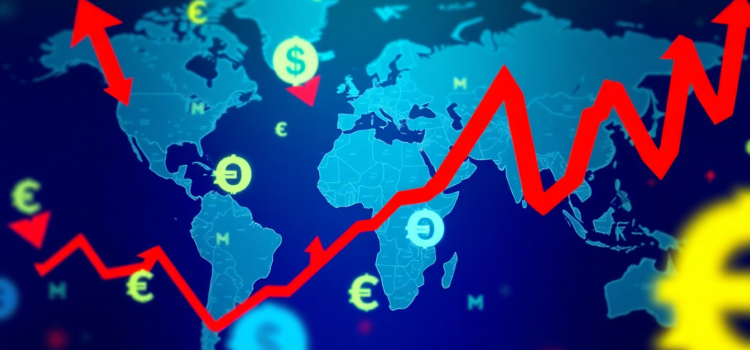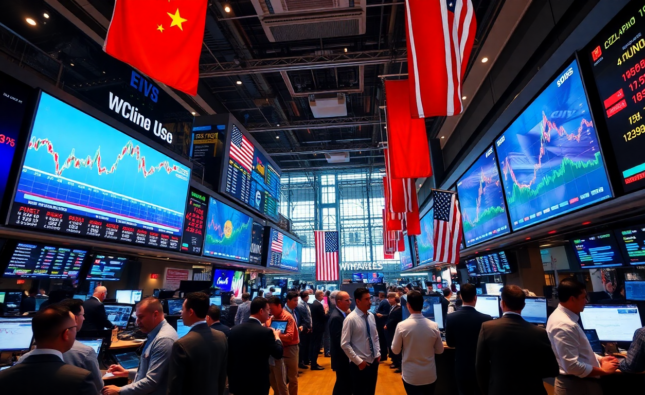
Global Markets Face Uncertainty Amid Economic Shifts and Data Fluctuations
The global economic landscape is undergoing a profound transformation as markets grapple with uncertainty amid shifting economic policies and fluctuating data. With global GDP growth projections for 2025 ranging between 2.3% and 3.3%, the specter of a recession looms large over the world’s economies. In this blog post, l will delve into the myriad factors contributing to this uncertainty, exploring how policy shifts, trade tensions, and financial turbulence are reshaping the global market dynamics.
Global Growth Slowdown Projections
The International Monetary Fund (IMF) projects a modest global growth of 3.3% for both 2025 and 2026. However, some analyses forecast a significant slowdown, with growth potentially dipping as low as 2.3% in 2025. This deceleration marks a stark contrast to pre-pandemic rates, casting a shadow over global economic prospects. Key factors leading to this global growth slowdown include stringent monetary policies and heightened economic policy uncertainty.
Market Volatility and Financial Turbulence
With the Economic Policy Uncertainty Index reaching its highest level this century, and the US financial “fear index” climbing to its third-highest reading, markets are entrenched in a state of heightened volatility and financial turbulence. These indices reflect underlying anxieties affecting investor confidence and market dynamics globally.
April 2025 witnessed sharp market corrections, culminating in significant losses across global equities. These erosions in value underscore the precariousness pervading financial markets, necessitating vigilant risk management in uncertain markets. Policymakers and investors alike must navigate these turbulent waters with strategic acuity.
Shifting Global Trade Policies
Trade policy dynamics, characterized by tariff escalations and emerging international trade tensions, are reshaping global supply chains. Projections indicate a 0.2% decline in global merchandise trade in 2025, with North American exports expected to fall dramatically by 12.6%. In a worst-case scenario, global trade could shrink further, primarily due to these escalating tariffs and burgeoning geoeconomic fragmentation trends.
Such disruptions to trade architectures raise input costs, erode real incomes, and heighten emerging market vulnerability. Organizations must adapt their investment strategies amid economic shifts, crafting policy responses to mitigate these adverse impacts.
Impact of Interest Rate Hikes on Growth
The Federal Reserve’s decision to maintain high interest rates through the end of the year is a critical factor underpinning global growth prospects. As inflationary pressures linger, monetary policy responses have been cautious, waiting for clear signs of inflation easing. This sustained tightening has profound implications on economic growth, contributing to the muted growth forecasts.
With global inflation projected to fall to 4.5% in 2025, advanced economies are anticipated to achieve target levels more swiftly than their emerging counterparts. Investors should consider cross-border investment risk assessments to navigate these challenges effectively.
Global Market Uncertainty: Conclusion and Takeaways
In conclusion, the current landscape of global market uncertainty demands a nuanced understanding of the multifaceted economic shifts occurring in 2025. Organizations and investors should engage in comprehensive risk management, informed by data science in economic forecasting, to navigate this complex environment.
As l continue to monitor macroeconomic trends emerging in 2025, l encourage active engagement with these developments. Stakeholders are urged to align their strategies with shifting dynamics, innovating to sustain resilience in the face of globally interconnected challenges.
FAQ Section
What are the factors contributing to global market uncertainty?
The primary factors include shifting global trade policies, trade tensions, financial market fluctuations, and economic policy uncertainty.
How is economic growth expected to progress in 2025?
Global growth is forecast to slow to between 2.3% and 3.3%, with emerging markets facing higher challenges due to policy volatility and trade disruptions.
What impact do interest rate hikes have on global growth?
Interest rate hikes contribute to slower economic growth by maintaining tight monetary conditions, affecting both advanced and emerging economies.
How might investors strategize amid economic shifts in 2025?
Investors should leverage data science for economic forecasting, engage in cross-border investment risk assessments, and explore diversified portfolios to mitigate risks.
What long-term implications arise from international trade tensions?
Prolonged trade tensions can lead to geoeconomic fragmentation, escalating costs, and diminishing real incomes, particularly affecting export-dependent economies.













Comments